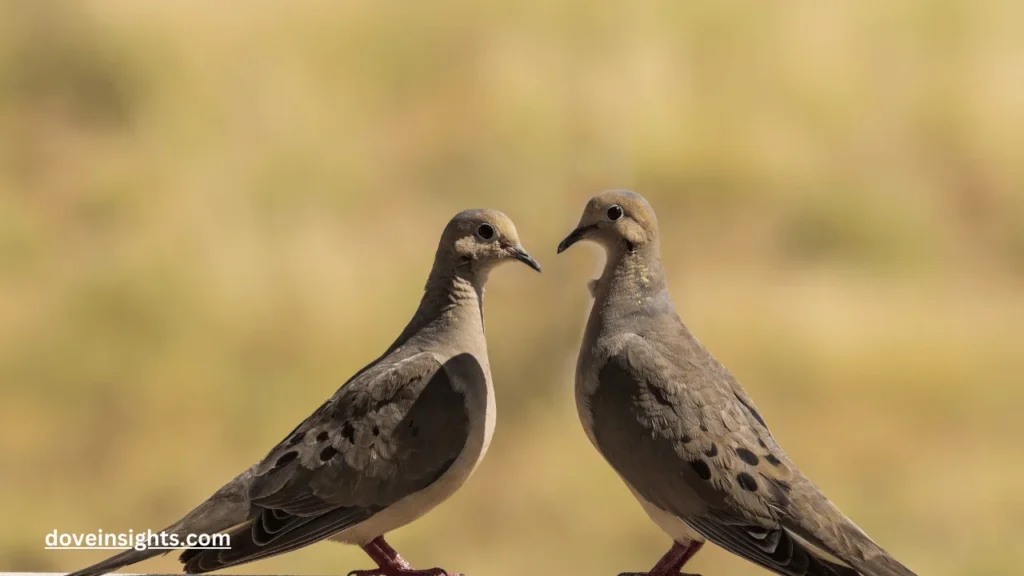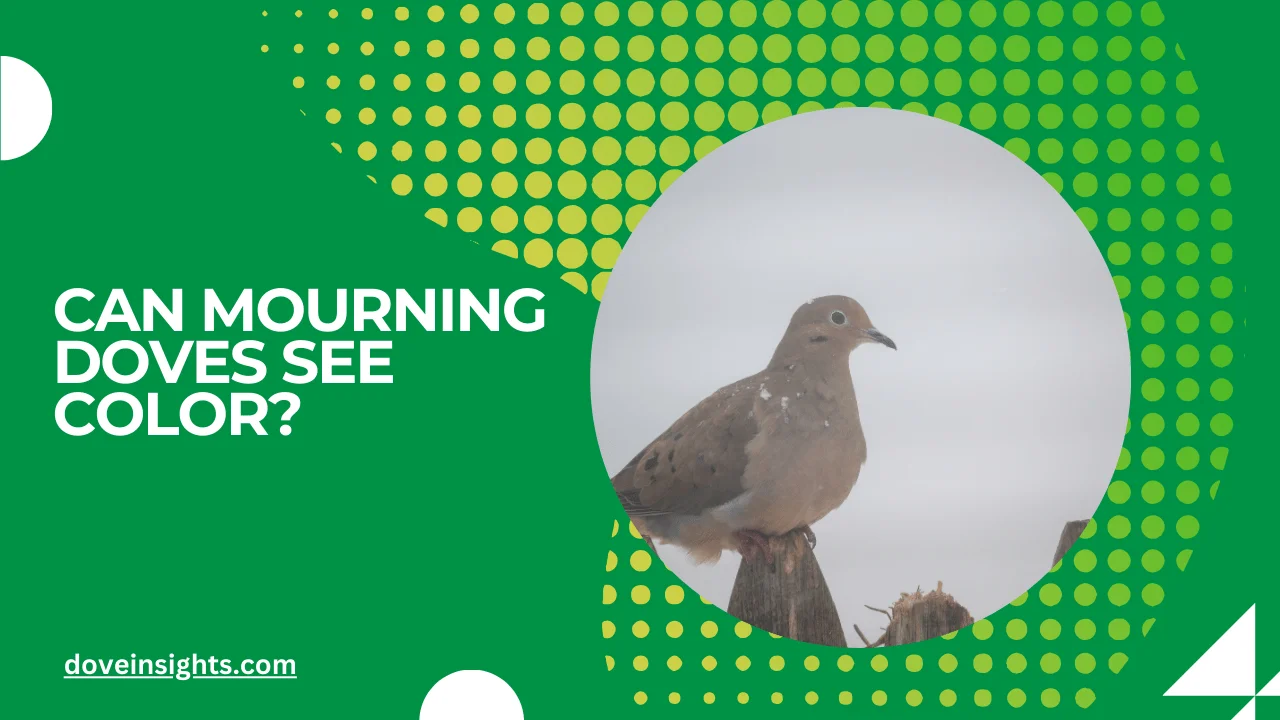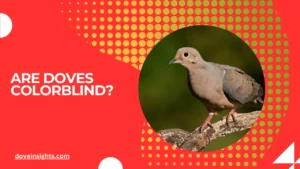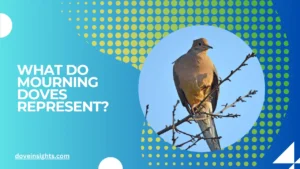Imagine walking through a lush, sunlit park, when suddenly, a mourning dove gracefully flutters by, its soft coos filling the air.
As you watch this serene creature, you might wonder: How much of the world does the mourning dove really see? Do these birds perceive color in the same way humans do, or is their vision limited to only certain hues?
While we often associate doves with peace and symbolism, their sensory capabilities—particularly vision—remain somewhat mysterious. The question of whether mourning doves can see color is not just a matter of curiosity but also reveals deeper insights into how these birds navigate their world, find food, and avoid predators.
In this article, we explore the fascinating science of avian vision, diving into whether mourning doves are capable of seeing a full spectrum of colors like humans—or if their perception of the world is fundamentally different.
Contents
- 1 How Do Birds See the World? Understanding Avian Vision
- 2 Do Mourning Doves See Color the Same Way Humans Do?
- 3 The Role of Color in Mourning Dove Behavior
- 4 The Science Behind Mourning Dove Vision: How Do We Know They See Color?
- 5 FAQ’s
- 5.0.1 Can mourning doves see color?
- 5.0.2 How is mourning dove vision different from human vision?
- 5.0.3 What is the role of UV vision in mourning doves?
- 5.0.4 Do mourning doves see the same colors as humans?
- 5.0.5 How does mourning dove vision help them survive?
- 5.0.6 Can mourning doves see the same colors as other birds?
How Do Birds See the World? Understanding Avian Vision
To understand whether mourning doves can see color, it’s important to first look at how birds, in general, perceive their environment. Unlike humans, who rely heavily on three primary colors (red, green, and blue) to create the full spectrum, many birds—including mourning doves—have a much more complex vision system.
Birds are known for having tetrachromatic vision, meaning they possess four types of color receptors, or cones, compared to the three cones that humans have. These extra cones allow them to see ultraviolet light, which is invisible to us.
For mourning doves, this means they likely experience the world in a much richer and more vibrant palette than humans. Color vision plays a crucial role for these birds, particularly when it comes to recognizing mates, identifying food sources, and even navigating their environments.
In addition to color perception, mourning doves also have exceptional visual acuity. Their ability to detect subtle changes in movement is critical for avoiding predators and finding food.
This sharp vision aids them in recognizing the bright colors of ripe fruits, seeds, and flowers, which might be invisible or less distinct to other animals. So, while we may not fully understand how mourning doves perceive the world, we know that their vision is far more sophisticated than it appears.
Do Mourning Doves See Color the Same Way Humans Do?
While mourning doves do have color vision, it is unlikely that they see the world in the same way humans do. The human eye is built to perceive a spectrum of red, green, and blue, but mourning doves, like many birds, can detect ultraviolet (UV) light, which humans cannot.
This means that mourning doves can see a wider range of colors, including those in the UV spectrum.
The presence of UV light receptors allows mourning doves to distinguish between subtle differences in colors that are invisible to us.
For example, a flower that appears yellow or white to the human eye might look entirely different to a mourning dove, possibly glowing in shades of blue or violet. Additionally, mourning doves likely have a sensitivity to contrast, helping them to detect predators or potential mates from far distances.
However, mourning doves might not have the same color saturation or intensity in their vision that humans experience. The brightness or vividness of colors they see could be quite different, depending on how their brains process visual information.
Therefore, while mourning doves can certainly see color, their perception of it may be quite distinct from our own, providing them with a unique and possibly more enhanced view of the world.
The Role of Color in Mourning Dove Behavior
Understanding how mourning doves see color is more than just an academic curiosity—it has real-world implications for their behavior and survival. In nature, color plays a vital role in attracting mates, identifying food, and avoiding danger.
For example, mourning doves use visual signals to attract mates during the breeding season. Males may exhibit certain color patterns on their feathers, which are visible to other doves and signal fitness.
Their ability to detect these visual cues is crucial for successful mating. The color of seeds, fruits, and plants is another important factor that influences where mourning doves choose to forage. The ability to see specific colors enables them to identify ripe food sources, which is essential for survival.
Mourning doves also rely on their ability to detect contrast to avoid predators. The sharpness of their vision helps them detect predators like hawks or domestic cats, even from a distance.
This ability to perceive movement and recognize predatory threats is especially important for these birds, which are often targets for larger, more aggressive animals.
How Does UV Vision Affect Mourning Dove Behavior?
One of the most intriguing aspects of mourning dove vision is their ability to see ultraviolet (UV) light. Most mammals, including humans, cannot perceive UV light, but birds like mourning doves are equipped with specialized UV receptors in their eyes, allowing them to see into the UV spectrum. This gives them an advantage in a variety of ways.
For mourning doves, the ability to see UV light plays a critical role in mate selection.
UV patterns on feathers, which are invisible to humans, can signal health or genetic fitness to potential mates.
Studies have shown that birds can detect UV reflection from feathers, using this information to assess the suitability of a mate. Similarly, UV light helps mourning doves spot ripened fruit or seeds that might otherwise blend in with the surrounding environment.
Additionally, UV vision might help mourning doves navigate their environment more effectively. In dense habitats or open fields, the ability to see UV light could help them identify contrasts in their surroundings, providing greater clarity when flying or foraging.
The Science Behind Mourning Dove Vision: How Do We Know They See Color?

So, how do scientists know that mourning doves can see color, including UV light? The study of avian vision has made tremendous strides over the years, and scientists use a variety of methods to investigate how birds perceive the world.
One of the most common techniques involves analyzing the structure of birds’ eyes, specifically their retinas, which contain the light-sensitive cells responsible for vision.
Through retinal examinations and behavioral experiments, researchers have confirmed that mourning doves, like many birds, have four types of color receptors (cones) that allow them to perceive a wider range of colors than humans.
By using techniques like electroretinography (ERG), which measures the electrical response of the retina to light, scientists can understand the range of colors birds can detect, including UV light.
Further studies on foraging behavior and mate choice have also provided insights into the importance of color perception in mourning doves. For example, their ability to choose food or select mates based on color cues supports the idea that color is not only visible to them but plays a significant role in their survival and reproductive success.
Conclusion:
In conclusion, mourning doves have a remarkably sophisticated visual system that allows them to see a broad range of colors, including ultraviolet light. While their perception of color may differ from ours, it undoubtedly enhances their ability to survive, reproduce, and navigate the world around them.
From finding food and detecting predators to selecting mates, color vision plays a pivotal role in their daily lives.
Understanding how mourning doves see the world gives us a deeper appreciation for these graceful birds and their unique adaptations. So, the next time you spot a mourning dove in your backyard, remember that they may be seeing a world far more colorful and complex than we could ever imagine.
FAQ’s
Can mourning doves see color?
Yes, mourning doves can see color, including ultraviolet (UV) light, thanks to their tetrachromatic vision.
How is mourning dove vision different from human vision?
Mourning doves have four color receptors (cones) compared to the three that humans have, allowing them to see a wider range of colors, including UV light.
What is the role of UV vision in mourning doves?
UV vision helps mourning doves with mate selection, food identification, and environmental navigation.
Do mourning doves see the same colors as humans?
No, mourning doves perceive colors differently than humans due to their ability to see ultraviolet light, giving them a richer and broader color spectrum.
How does mourning dove vision help them survive?
Mourning dove vision aids them in detecting predators, choosing mates, and identifying food sources, all of which are essential for their survival.
Can mourning doves see the same colors as other birds?
Yes, like many birds, mourning doves have tetrachromatic vision, allowing them to see a broader range of colors compared to most mammals.








